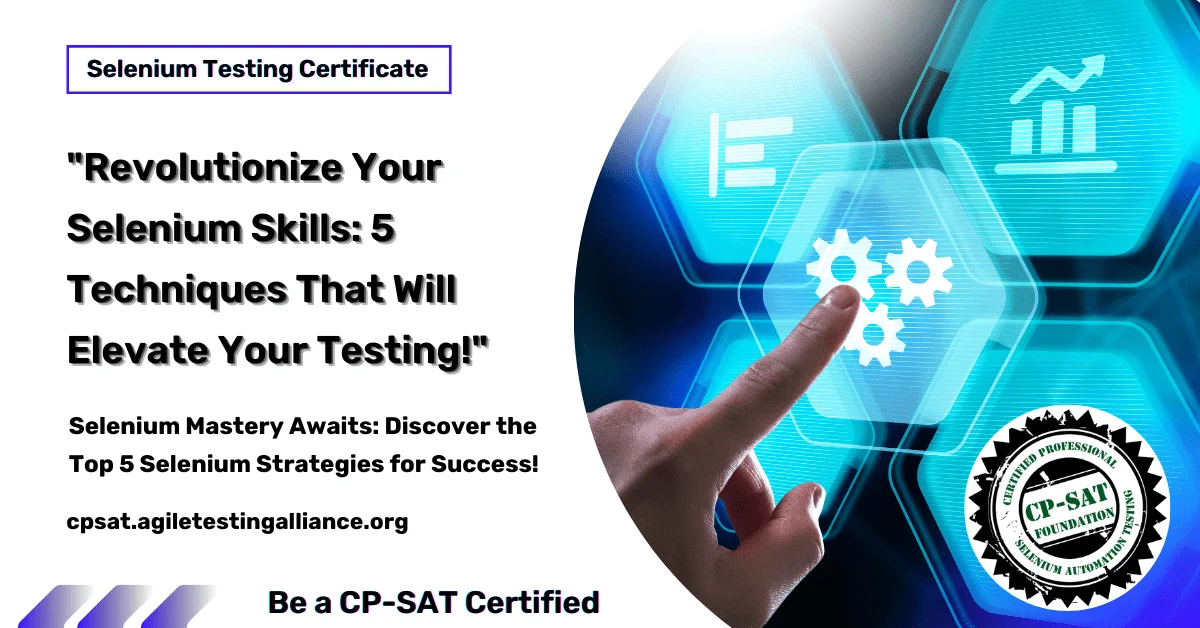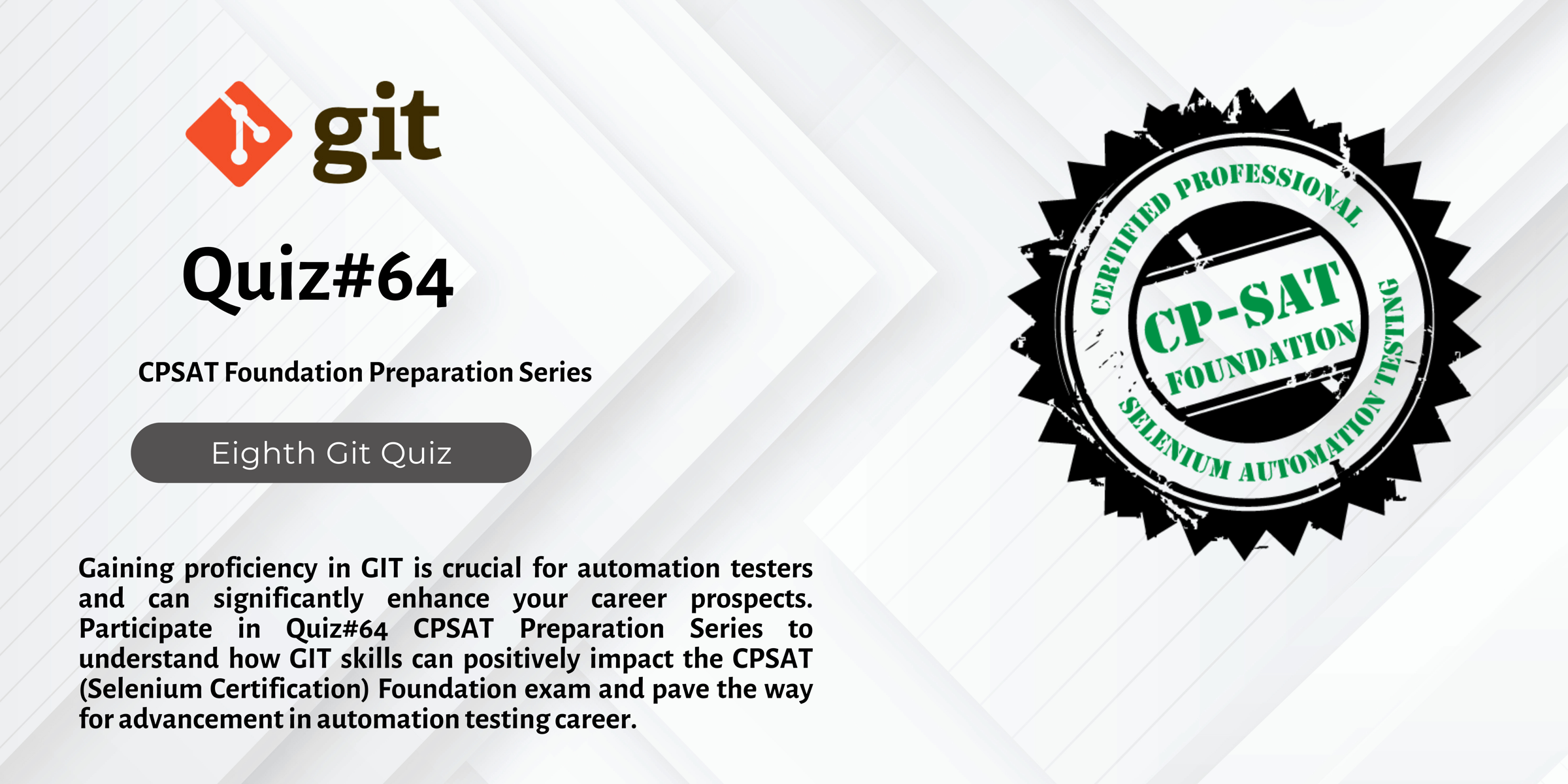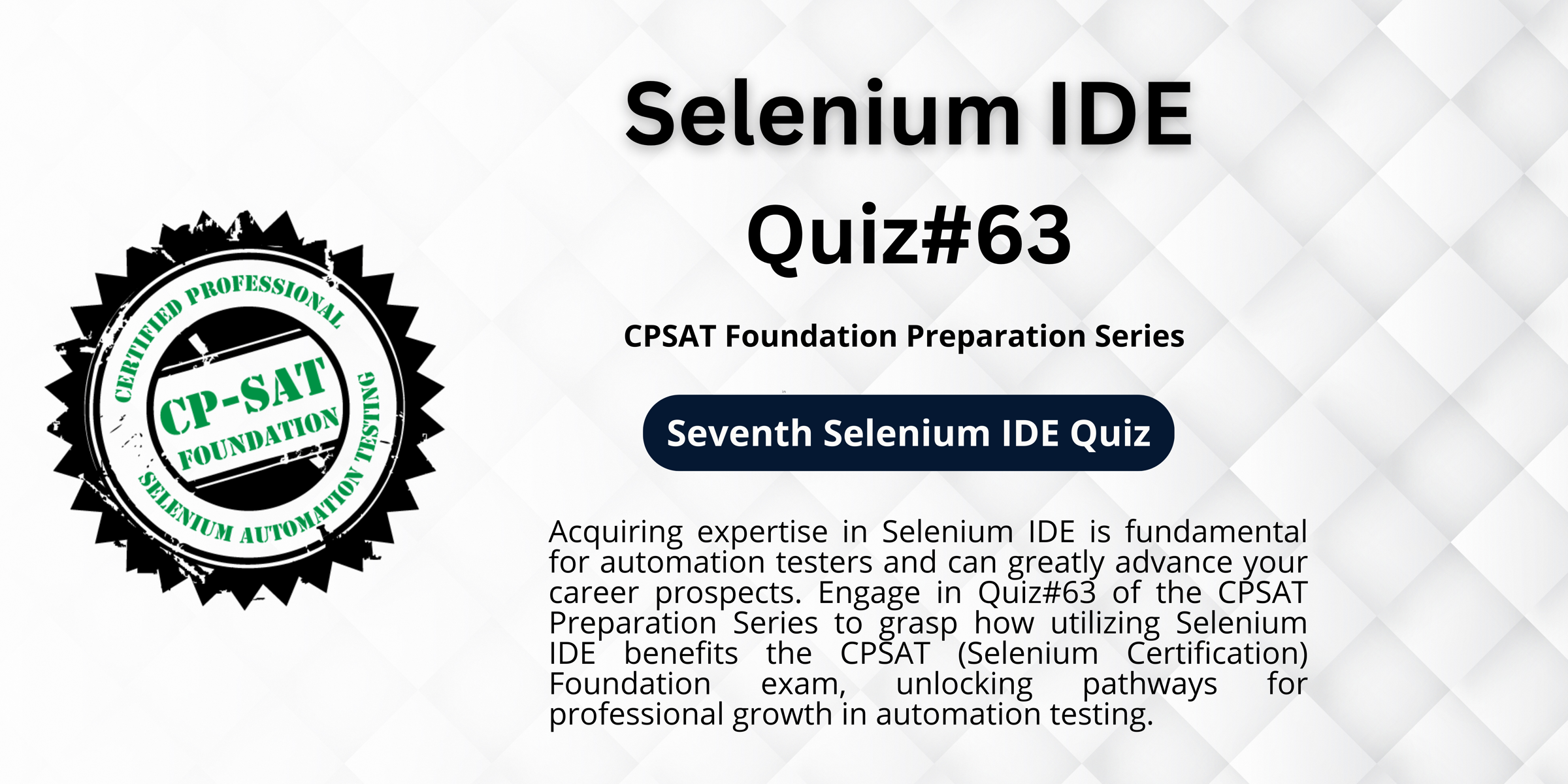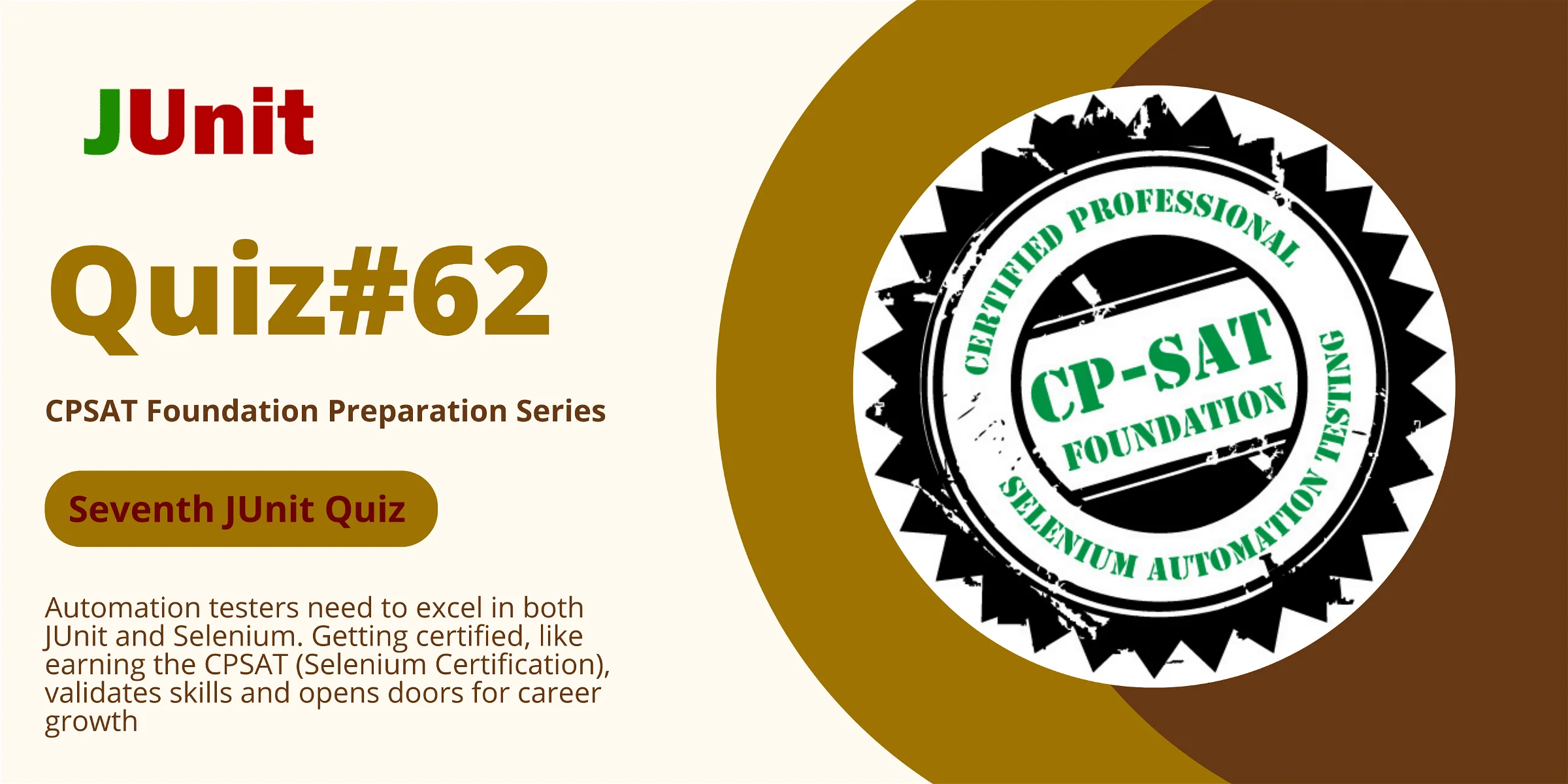Unlock the Power of Selenium: A Quick Start Guide

Table of Contents
Hello and welcome, aspiring software testers and developers! If you’re stepping into the captivating world of software testing, you’ve arrived at the right place. Today, we’re diving deep into one of the industry’s most versatile and powerful tools: Selenium. In our hyper-connected, digitally-driven landscape, the demand for robust and reliable web applications is soaring, not just in Silicon Valley but across the globe. And that’s where Selenium comes into play, empowering you to ensure software quality like never before.
Now, you may ask, “Why should I focus on Selenium?” Well, in a nutshell, Selenium offers you the freedom to script in multiple programming languages such as Java, Python, and C#. This flexibility is unparalleled when compared to other testing tools, making it a go-to resource for testing professionals globally. Whether you’re located in Bangalore or Boston, the Selenium framework enables you to write tests that are as versatile as they are powerful.
The aim of this Quick Start Guide is straightforward: to provide you with the key essentials and actionable insights for a smooth journey into Selenium testing. Even if you’re a fresher or a newcomer, don’t fret. This guide is designed to be a comprehensive yet easy-to-follow roadmap, breaking down complex topics into digestible pieces. From setting up your first test environment to understanding advanced topics like Data-Driven Testing and Selenium Grid, we’ll cover it all.
As we embark on this exciting voyage together, you’ll discover that Selenium isn’t just a tool; it’s an ecosystem. An ecosystem that’s capable of adapting to new web technologies, automation trends, and the ever-changing demands of the software industry.
So, strap in and get ready to unlock the unlimited potential of Selenium! By the end of this guide, you’ll have the foundational knowledge to jumpstart your career in the high-demand field of software testing, no matter where in the world you’re located.
The Evolution of Web Testing:
From Manual Checks to Automated Excellence
Ah, web testing! Let’s take a stroll down memory lane and look at how this cornerstone of software quality assurance has evolved over the years. Back in the day, when the internet was still in its infancy, testing web applications was, let’s be honest, a bit of a manual slog. Yes, the good old days of manual testing—where every click, every form, and every link were tested by human hands.
Now fast forward to our current tech-savvy era, where ‘Agile’ and ‘DevOps’ aren’t just buzzwords; they’re part of the daily lingo for software development teams around the globe. In this landscape, speed is the name of the game. Companies from San Francisco to Singapore are churning out updates faster than you can say ‘scrum.’ But how can you maintain high-quality software in this rapid-fire environment? Enter automated testing tools like Selenium.
You see, automated testing isn’t just a fad—it’s an essential component of modern software development. We’ve moved from checking a website’s functionality one click at a time to running hundreds, if not thousands, of tests simultaneously, thanks to automation frameworks. Selenium, with its ability to support multiple browsers and languages, stands at the forefront of this revolution, globally embraced for its adaptability and robustness.
As you delve deeper into web testing, you’ll often come across terms like ‘Cross-Browser Compatibility,’ ‘Regression Testing,’ and ‘Continuous Integration.’ These aren’t just technical jargons; they’re key aspects of what makes a good testing strategy in our interconnected, globalized world. And guess what? Selenium excels in each of these areas. Whether you’re in Berlin or Bangalore, Selenium provides you with the tools to ensure that your website or application performs optimally across a wide array of environments.
So why is this history lesson crucial for you, especially if you’re a fresher or a newcomer? Well, understanding the evolutionary journey of web testing gives you invaluable context. It helps you appreciate not just the ‘what’ but the ‘why’ behind the tools and techniques you’ll soon be mastering. The evolution of web testing is a testament to the industry’s growth, and as you’re starting out, it’s essential to know that you’re stepping into a field that values innovation and global collaboration.
Why Selenium? Making the Right Choice in the World of Automated Testing
Ah, the golden question: “Why Selenium?” If you’re stepping into the vast realm of software testing, you might find yourself at this crossroads, pondering which tool to arm yourself with. And let me tell you, the answer matters, not just for your immediate project but also for your long-term career prospects, especially in the ever-globalizing tech landscape. So, without further ado, let’s delve into the compelling reasons to pick Selenium as your go-to testing framework.
Universal Compatibility: A Global Standard
First and foremost, Selenium’s compatibility is nothing short of universal. That’s right; this powerhouse framework supports multiple browsers like Chrome, Firefox, Safari, and IE. So no matter where in the world you’re testing from or what your target market uses, Selenium has got you covered. Keep an eye out for high-volume search terms like “Selenium browser compatibility” or “Cross-browser testing tools” for more details.
The Gift of Language: Code as You Like It
Now, let’s talk programming languages. If you’re adept at Java, great. More of a Python person? Fantastic. Selenium is that flexible friend who speaks multiple languages—Java, Python, C#, Ruby—you name it! This is especially beneficial in a global setting where development teams often work across different technology stacks.
Open-Source Brilliance: Your Budget’s Best Friend
Ah, the sweet word—“open-source.” The lack of licensing costs makes Selenium an attractive choice for startups and enterprises alike. When you’re eyeing global scalability, every penny saved counts. For newcomers, this is an opportunity to dive into Selenium without the hurdle of procuring expensive licenses.
Continuous Integration: The DevOps Darling
Transitioning into another crucial point—DevOps. As companies globally adopt DevOps practices, Selenium fits right in with its seamless integration capabilities. Whether it’s Jenkins, Docker, or Travis CI, Selenium can effortlessly sync with these technologies, making it indispensable in the Continuous Testing phase.
Community and Documentation: A Worldwide Support Network
Another significant advantage that can’t be overlooked is Selenium’s robust community and exhaustive documentation. This global support network can be a lifesaver, especially for freshers. When you’re stuck or seeking inspiration, a community of experts is just a forum away, waiting to assist you.
Future-Proof Your Career: Always on the Cutting Edge
Last but not least, Selenium keeps evolving. With Selenium 4 already making waves, staying updated with this framework ensures you’re always aligned with industry standards.
Wrapping It Up
So, as we wrap up this conversation, the message is crystal clear: Selenium isn’t just a tool; it’s an investment in your future. Its wide-ranging capabilities and adaptability make it a global frontrunner in the testing arena. And for someone just starting, what better platform to launch your career from? Now, go ahead and take that plunge into the world of Selenium; it’s a decision you’re unlikely to regret.
Understanding Selenium’s Components: The Building Blocks of Your Testing Strategy
Let’s get straight into the meat of the matter—Selenium’s core components. If you’re just taking your first steps into the realm of software testing, this section will lay the foundation of your Selenium journey. So, buckle up as we demystify the pillars of Selenium and how they converge to make this tool an indispensable asset in automated testing.
Selenium IDE
Starting off, we have Selenium IDE, or Integrated Development Environment. Think of it as the kindergarten of Selenium, a place where you can play around, make mistakes, and learn without any steep learning curves. It’s a simple, browser-based tool that’s perfect for creating quick and dirty scripts. With the power of “record and playback,” even newcomers with limited programming skills can get a feel of what automated testing is all about. In today’s fast-paced DevOps cycles, Selenium IDE acts as the go-to tool for quick validations.
Selenium WebDriver
Next in line, meet the superstar—Selenium WebDriver. This is the big league, folks! WebDriver allows you to perform more complex actions and interact with web elements in a way that mimics real user behavior. Now, why is WebDriver a game-changer? Because it integrates seamlessly with various programming languages like Java, Python, and C#, offering a versatile and flexible testing environment. From Silicon Valley startups to tech hubs in Bangalore and Tel Aviv, WebDriver is the global standard for automated web testing.
Selenium Grid
Last but not least, let’s talk about Selenium Grid. This is your tool for parallel testing, meaning you can run multiple tests across different browsers and operating systems simultaneously. In a world obsessed with speed and efficiency, Selenium Grid is your golden ticket to faster testing cycles. Trust me, once you start leveraging Grid, there’s no turning back.
Selenium 4.x: The Latest and Greatest
Ah, before we wrap up, a nod to Selenium 4.x, the latest version at the time of writing. It’s packed with features like a new plugin system and improved WebDriver capabilities. If you’re aiming for cutting-edge skills, this is where you need to focus.
So, why should a fresher or a newcomer pay attention to these components? Understanding Selenium’s building blocks equips you with the knowledge to choose the right tools for the right job. It’s all about knowing your arsenal. You’ll be better prepared to tackle real-world scenarios, be it in local markets or on a global scale.
To sum up, Selenium isn’t just a tool; it’s an ecosystem. Its various components offer a holistic approach to automated web testing, making it globally relevant and incredibly scalable. So whether you’re in New York or New Delhi, Selenium has something for everyone.
Setting up Your Environment: Your First Step to Selenium Mastery
Hello budding test engineers! Now that we’ve tackled what makes up the robust ecosystem of Selenium, it’s time to roll up our sleeves and get into action. Yes, you guessed it right; we’re diving into setting up your testing environment. It’s an unmissable chapter in your Selenium story, as a properly configured workspace is vital for efficient and hassle-free testing. Whether you’re in the buzzing tech cities of San Francisco or the emerging tech capitals like Bangalore, setting up a functional workspace is a universal necessity.
Choose Your Programming Language Wisely
First things first, choosing the programming language that will power your Selenium tests. Do you want to go for Java, Python, or maybe C#? Remember, your choice here will impact your future work, so make sure to pick the language you’re most comfortable with. If you’re an absolute beginner, Python might be the best bet for its simplicity.
Install Necessary Software
Next up, it’s time for some software installations. You’ll need an IDE (Integrated Development Environment), like Eclipse or IntelliJ for Java, or PyCharm for Python. Don’t worry; these are mostly free to use and easy to install. Just follow the step-by-step guides available on their respective websites.
WebDriver Configuration
Ah, the pivotal moment has arrived—configuring WebDriver. Trust me, it’s not as complicated as it sounds. After you’ve downloaded the WebDriver that corresponds to the web browser you’ll be testing on (ChromeDriver for Chrome, GeckoDriver for Firefox, etc.), it’s all about linking it to your IDE. In the case of Java, you’ll be adding the WebDriver JAR files to your project libraries.
Running Your First Test
And now, the moment we’ve all been waiting for—running your first test. With your IDE open, create a new class or Python file, and write a simple script that opens a web browser and navigates to a webpage. Click “Run,” and you should see the magic happen right before your eyes. Congratulations, you’ve just run your first automated test!
Bonus Tip: Version Control with GIT
I’d also recommend getting familiar with a Version Control System like GIT. It’s an industry standard and will make your life much easier when working on larger projects or collaborating with others.
So there you have it—a roadmap to setting up your Selenium testing environment, a task as essential in Manhattan as it is in Melbourne. Regardless of where you’re starting your software testing journey, these steps are universal.
In summary, setting up your environment is your first hands-on step in becoming a Selenium testing expert. Remember, every expert was once a beginner. Your environment is the canvas, and you’re the artist, ready to paint your testing masterpiece. Happy testing!
Writing Your First Selenium Test: A Milestone in Your Testing Journey
Welcome back, future Selenium aficionados! After successfully setting up your environment, you must be eager to write your first Selenium test. Trust me, this is the moment that separates the dabblers from the devotees. It’s a crucial step, as essential in New York as in New Delhi, and will serve as the foundation of all your future test scripts. So, let’s get right into it.
Starting with the Basics: Launching a Web Browser
Before we dive deep into writing complex test scenarios, let’s start with the basics. Your first Selenium test will simply launch a web browser. How exhilarating is that! If you’re using Java, your code will start with importing Selenium WebDriver libraries. For Python enthusiasts, the from selenium import webdriver line will be your new best friend.
Navigate to a Webpage: Your First Interaction
The next step is to navigate to a website. Let’s say we’re aiming for a straightforward task—opening Google’s homepage. Using the WebDriver, this can be accomplished with a single line of code like driver.get(“https://www.google.com”); in Java or driver.get(“https://www.google.com”) in Python. If you see Google’s familiar interface pop up, give yourself a pat on the back!
Interacting with Web Elements: The Real Fun Begins
Here’s where things get interesting. It’s time to interact with some web elements. Whether you’re inputting text into a search box or clicking a button, WebDriver provides various methods to interact with elements on a webpage. For instance, if you’d like to type “Selenium tutorial” into Google’s search box, you’d first locate that element and then send your keyword. It’s as easy as driver.findElement(By.name(“q”)).sendKeys(“Selenium tutorial”); in Java.
Running the Test: Watch the Magic Unfold
You’ve written your lines of code, and now it’s showtime! Click the “Run” button in your IDE and watch the browser launch, navigate to Google, and type in your search query. If everything goes as planned, you’ve just executed your first Selenium test.
There you have it! Your first Selenium test script from start to finish. Remember, Rome wasn’t built in a day, and neither will your Selenium expertise be. But this first test is a monumental step, a rite of passage that brings you into the fold of Selenium testers. Happy coding, and as always, stay curious and keep testing!
Diving Into Selenium Frameworks: Your Next Leap in Automation Testing
Greetings, future test automation architects! If you’ve come this far, you’re already on the path to becoming a Selenium virtuoso. Now that you’ve got the hang of writing your first Selenium tests, let’s take things up a notch. Just as a samurai wouldn’t go to battle with only one technique, neither should you go into test automation with just basic scripts. Enter Selenium frameworks—a crucial tool that will make your life in automation simpler, whether you’re testing in Tokyo or Timbuktu. So, let’s get cracking!
The What and Why: Understanding Selenium Frameworks
To kick things off, what exactly is a Selenium framework? Think of it as a systematic, reusable structure that will help you execute your tests more efficiently. Frameworks lay down a set of guidelines or best practices to follow, making the entire process more organized and manageable. A well-crafted framework not only speeds up test case creation but also enhances the maintainability and scalability of your test suite. It’s like the difference between a cluttered desk and a neatly organized workspace; both can get the job done, but one is far more efficient and pleasant to work with.
The Big Three: Types of Selenium Frameworks
As you venture into the world of Selenium frameworks, you’ll come across three main types: Data-Driven, Keyword-Driven, and Hybrid Frameworks. Each has its own unique attributes and use-cases, offering a wide range of flexibility. While Data-Driven frameworks excel at handling multiple sets of data, Keyword-Driven frameworks provide a higher level of abstraction, making your test scripts easier to understand. Hybrid Frameworks, as the name suggests, bring the best of both worlds. No matter the framework you choose, mastering them is a must-have skill in today’s competitive job market.
Setting Up Your Framework: The Building Blocks
Getting started with setting up a framework can seem daunting, but don’t worry; we’ll break it down into manageable steps. Whether you’re using Java with TestNG or Python with Pytest, the first task is to set up a project structure. Next, install the necessary libraries and dependencies. After that, it’s all about creating reusable components, identifying test cases, and writing your test scripts according to the chosen framework’s guidelines. As you work through this, you’ll find your efficiency and productivity skyrocketing.
Reaping the Benefits: Why Frameworks Matter
After setting up and executing tests within a framework, you’ll quickly see the advantages. Your test cases will be more maintainable, your test data better organized, and your overall process far more efficient. Plus, frameworks provide easy-to-read reports that are invaluable in catching issues before they reach the end-users, saving both time and money in the long run.
There you go! A primer on diving into Selenium frameworks. Trust me, this skill set is your ticket to elevated career opportunities and the ability to tackle complex projects with confidence. So, arm yourself with this knowledge and keep testing—because the world of Selenium frameworks is where the real magic happens!
Advanced Topics to Explore: Unlocking the Full Potential of Selenium Testing
Congratulations on making it this far! You’ve dabbled in the basics, written your first Selenium tests, and even started working with frameworks. But just as the universe doesn’t end with our solar system, the realm of Selenium has depths yet unexplored. So, fasten your seat belts because we’re about to go on an interstellar journey through some advanced topics in Selenium testing.
Cross-Browser Testing: The Universal Skillset
First on the agenda is cross-browser testing. Imagine you’ve developed a top-notch website or application. However, it only works well on Google Chrome, while millions of people around the world use Firefox, Safari, or even Microsoft Edge. That’s a problem, isn’t it? Mastering cross-browser testing ensures your application offers a consistent user experience, no matter the browser in use. This is essential for ensuring global compatibility and, subsequently, broadening your career horizons.
CI/CD Integration: Where Speed Meets Quality
Continuous Integration and Continuous Deployment (CI/CD) are not just trendy buzzwords; they’re a revolutionary approach that’s fast becoming the industry standard. They allow for the rapid yet reliable delivery of software by automating various stages of the development process. Learning to integrate your Selenium tests into a CI/CD pipeline using tools like Jenkins or GitLab CI can significantly elevate your testing game.
Mobile Testing: The New Frontier
In today’s mobile-first world, understanding how to use Selenium for mobile testing is a game-changer. This involves tools like Appium, a Selenium derivative specially designed for mobile applications. As mobile phones become increasingly ubiquitous, so does the need for mobile application testing. Learning this opens up a new world of career opportunities that span across continents.
Dockerization and Selenium Grid: Scaling Your Tests
Selenium Grid and Docker are instrumental in achieving parallel execution of tests, thereby saving time and computational resources. Docker containers provide an isolated, consistent environment for your tests, making them easily portable across systems. Trust me, knowledge of Docker and Selenium Grid is an attractive line on any tester’s resume!
Page Object Model (POM): Organization at Its Best
Last but not least, the Page Object Model or POM. It’s an excellent way to structure your Selenium scripts for better maintenance and readability. If you’re a fan of neat and organized work, POM is your go-to methodology.
To wrap things up, venturing into these advanced topics will not only make you a Selenium Testing connoisseur but also a much-sought-after professional in the global marketplace. Remember, the key to being exceptional is in constantly evolving. So dig deep into these advanced topics, and who knows, you might become the next big name in the Selenium testing universe!
Case Studies and Real-world Applications: Practical Insights into Selenium Testing
Ah, the theoretical aspects are fascinating, aren’t they? But what about the real world? How does all this Selenium wizardry apply when you’re on the job, facing actual challenges? Trust me, theory and practice go hand-in-hand. That’s why we’re diving into some impactful case studies and real-world applications of Selenium. These stories serve as a treasure trove of experience, each telling its own tale of problem-solving, innovation, and yes—occasional setbacks.
Case Study 1: E-commerce Website—Optimizing User Experience
First on the list is an e-commerce website, one that we’ve all frequented at some point. This case study reveals how Selenium was used to perform automated regression testing, thereby ensuring that new features didn’t break existing functionalities. This level of scrutiny was instrumental in delivering a seamless user experience, irrespective of the browser or device used. So the next time you click to buy without glitches, know that there’s a tester somewhere who made that happen!
Case Study 2: Financial Services—Security and Performance Testing
When it comes to financial services, we’re talking about a sector where the slightest error can have enormous ramifications. Here, Selenium was employed for rigorous security and performance testing. Specialized Selenium scripts were designed to mimic complex user behavior, revealing hidden vulnerabilities that could be potential goldmines for hackers. This case offers a practical example of how Selenium meets the global standards for cybersecurity.
Case Study 3: Health Tech Startup—Scalability and Accessibility
Here’s where things get futuristic! A burgeoning health tech startup embraced Selenium for its scalability tests. With Selenium Grid and Docker, they managed to simultaneously run multiple tests, dramatically cutting down the testing time. But what’s more exciting is how Selenium’s accessibility testing features were used to make the app universally accessible, addressing a truly global need for inclusive healthcare solutions.
Case Study 4: Social Media Platforms—Cross-browser Testing
In an age where social media platforms are ubiquitous, ensuring uniform functionality across different browsers is a monumental task. Selenium excels here as well, offering robust cross-browser testing solutions. This case study reveals how a social media giant used Selenium to guarantee a smooth user experience across the globe, showcasing the versatility and global relevance of Selenium testing.
The Global Perspective
These case studies are not just isolated instances; they echo the global challenges that testers face every day. Each study encapsulates a unique problem, an innovative solution, and the resultant impact, often on a global scale.
To sum up, diving into real-world case studies isn’t just eye-opening—it’s transformational. It offers you not just a skill but a perspective, equipping you to be a global player in the ever-evolving field of Selenium Testing. So, roll up your sleeves and let these case studies be your playground as you prepare for the grand stage that is the world of software testing!
Conclusion: The Road Ahead for Aspiring Testers in the World of Selenium
Well, here we are—after a comprehensive tour through the evolution of web testing, understanding Selenium’s components, setting up your environment, writing your first test, diving into Selenium frameworks, exploring advanced topics, and immersing ourselves in real-world applications. The one message I want to resonate with you is this: The world of Selenium Testing is as vast as it is exciting, and you’re just at the beginning of what could be a thrilling, fulfilling career.
The Global Importance of Selenium Testing
You see, in our digital age—characterized by software that’s always “on” and global in reach—Selenium has proven itself invaluable. With its ability to handle different browsers, languages, and platforms, Selenium isn’t just a tool; it’s a passport to a world of possibilities in software quality assurance.
The Future Is Bright, and So Are You!
Trust me, the future is promising. We’re talking about automated testing becoming an integral part of DevOps, the rise of AI in testing, and Selenium 4 shaping up to be a game-changer.
The Newcomers’ Advantage
For freshers and newcomers, this is the perfect time to hop on board. The industry is keen on finding individuals who not only bring technical expertise but also display a thorough understanding of global market trends. The dynamism of Selenium—its constant updates and vibrant community—is an open invitation for you to continually learn and evolve.
The Global Community and You
Whether you’re in San Francisco or Singapore, Berlin or Bangalore, the Selenium community is a globally interconnected network of professionals, all contributing toward making software safer, more efficient, and more inclusive. You’re not just a tester in isolation; you’re part of a global movement.
Wrapping It Up
So, as we wrap up this guide, remember: Learning Selenium isn’t just about mastering a tool. It’s about understanding its impact on the broader world, its relevance in various industries, and its significance in shaping digital experiences universally. Armed with this knowledge and inspired by real-world applications, you’re ready to make your own mark in the ever-expanding Selenium universe.
Welcome to the beginning of your journey in Selenium Testing. It’s going to be an exhilarating ride!
FAQs
Great place to start! Globally, Selenium has established itself as a cornerstone in the realm of automated web application testing. Its unparalleled versatility enables testers all around the world to work on various browsers, platforms, and programming languages.
The short answer: Yes, but you don’t have to be a coding wizard. Basic knowledge of programming languages like Java, Python, or C# will suffice. It makes your transition into Selenium a smoother ride. Learning programming is not just about writing code; it’s about developing a way of thinking that’s crucial for problem-solving in the testing landscape.
This is a hot topic, especially given the ever-increasing embrace of DevOps practices worldwide. Selenium plays a pivotal role in Continuous Testing, a key component of the DevOps cycle. Keywords to look into include “Selenium and DevOps Integration” and “Continuous Testing.”
Choices, choices! Whether it’s Data-Driven, Keyword-Driven, or Hybrid frameworks, the “best” framework largely depends on your project requirements. For freshers, I’d recommend starting with the basics of each framework and then diving deep into one. Remember, expertise in a particular framework can make you a valuable asset not just in your local job market, but globally as well.
In a word, absolutely. Selenium 4 is becoming a game-changer in the automated testing industry. With new features like improved grid capabilities and relative locators, this updated version is streamlining the testing process like never before. Watch for keywords like “Selenium 4 Features” and “Selenium 4 vs Selenium 3.”
I’m glad you asked! With a growing demand for quality assurance in software globally, Selenium testers have a bright career path ahead. Industries ranging from e-commerce to fintech, from gaming to healthcare, all require proficient Selenium testers. “Selenium Career Growth” and “Global Selenium Job Market” are phrases that can offer you more insights.
Ah, the CP-SAT—Certified Professional Selenium Automation Testing—a credential that can potentially be a game-changer in your testing career. So, what makes it so special? CP-SAT is a globally recognized certification that validates your proficiency in Selenium testing.
If you’re contemplating whether to invest time and money in a CP-SAT certification, ponder no more. This certification can significantly boost your marketability, not just locally but on a global scale. Companies worldwide are increasingly seeking CP-SAT certified professionals.












